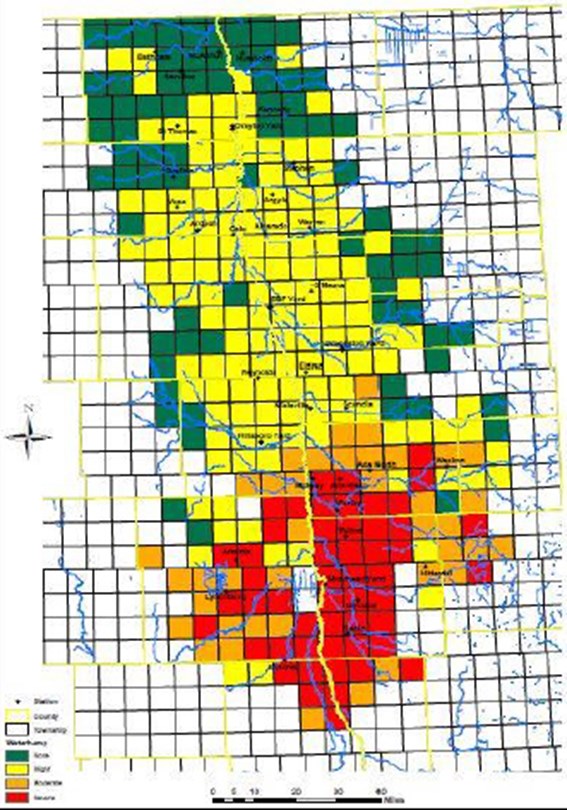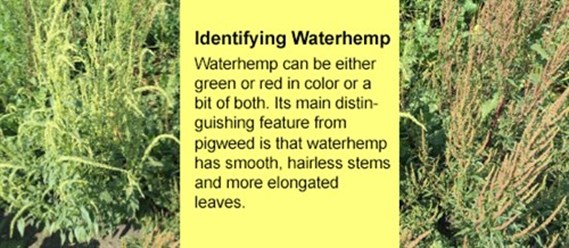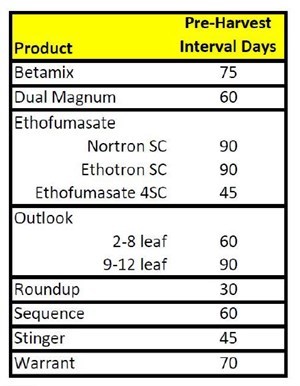611 - What’s Your Waterhemp Plan? The Best Defense is a Good Offense
Roundup resistant waterhemp infestations have progressed from the southern Red River Valley to the northern Red River Valley. The map below was created from 2019 observations made by American Crystal Agriculturists. It is important to have a proactive herbicide plan to have a chance at controlling resistant waterhemp. This includes the use of preplant incorporated/preemergence (PPI/PRE) herbicides and/or lay-by herbicide applications. Lay-by herbicides should be applied at the sugarbeet 2-leaf stage and before waterhemp emerges. This is because we don’t have effective postemergence (POST) herbicides for waterhemp control, especially for any type of rescue treatment (waterhemp greater than two inches tall). It is highly important to control waterhemp before it emerges. Remember one waterhemp plant can produce 300,000 seeds.

When & Why a PPI/PRE application makes sense
- Waterhemp emerges around mid-May and continues to emerge season long.
- There are known waterhemp control issues in situations of later than usual planting.
- Waterhemp often emerges shortly after planting and lay-by applications may not have been applied yet.
- Lay-by applications require rainfall for activation and may not be activated in time in late planting situations.
- A PPI or PRE application bridges the gap until a lay-by application can be applied.
Application Strategy for Waterhemp and Ragweed Control
- Ethofumesate
- Dual Magnum - only Syngenta branded S-metolachlor is approved PRE.
- Requires an indemnified label signature for PRE use. https://www.syngenta-us.com/labels/indemnified-label-login
- Ethofumesate + Dual Magnum combination
Post Applications
- 1st Application
- 28-32 fl oz/A Roundup + 6 fl oz/A ethofumesate + Stinger 2-4 floz/A
+ lay-by + AMS + HSMOC adjuvant
- 28-32 fl oz/A Roundup + 6 fl oz/A ethofumesate + Stinger 2-4 floz/A
- 2nd Application
- 28-32 fl oz/A Roundup + 6 fl oz/A ethofumesate + Stinger 2-4 floz/A
+ lay-by + AMS + HSMOC
- 28-32 fl oz/A Roundup + 6 fl oz/A ethofumesate + Stinger 2-4 floz/A
- 3rd application – if needed - Contact Agriculturist
- 22 fl oz/A Roundup + AMS
Notes
- Watch Pre-Harvest Intervals.
- Betamix, if available, can be used in all applications.
- Ethofumesate Total Max Post application = 12 fl oz/A.
- Stinger – not labeled for application past sugarbeet 8 leaf stage.
- Tank mixes need to have HSMOC adjuvant added.
- Tank-mixing with insecticides and Quadris is not recommended as sugarbeet injury may occur.
- Applications at temps over 85°F may cause sugarbeet injury.
Roundup PowerMax Max Single POST application:
- Emergence – 8 leaf stage = 32 fl oz/A
- 8 leaf stage – canopy closure = 22 fl oz/A
Roundup PowerMax Max Total POST use:
- Emergence – 8 leaf stage = 56 fl oz/A
- 8 leaf stage – canopy closure = 44 fl oz/A


Tank-mixing Order for Glyphosate and Conventional Herbicides
- Fill spray tank 1/2 full with clean water (warmed water is best)
- If used - Slurry UpBeet, Warrant in warm water (WDG’s)
- Add AMS liquid or dry (water conditioner)
- If used - Add Slurried WDG to tank
- If used - Add Nortron (SC)
- Fill 2/3 full of water
- Add Betamix, Progress, or Betanex, Outlook, Dual Magnum (EC)
- If used - Add Stinger (SL)
- Add glyphosate
- Add additives (NIS, COC, MSO, HSMOC and drift/deposition agents)
- Finish filling spray tank – continue agitation
- Spray tank empty as soon as possible, best to not let sit overnight.
PPI & PRE Options & Notes
PPI = Herbicide applied before light tillage pass then incorporated in top 2”. Preemerge = Herbicide applied after planting before crop has emerged.
PPI & PRE Applications need good soil coverage
- Apply with 15 gallons of water and medium – coarse droplets.
Ethofumesate - (Nortron SC, Ethotron SC, Ethofumesate 4SC)
- Activation requirement: 0.75” of rainfall
- PPI application allows for quicker activation
Rate: 2-3 pt/A
-
- Up to 4 weeks residual waterhemp control.
- Cover crop establishment will be compromised.
- Following crop: recommended to not be a grass (wheat, barley, corn).
Rate: 5–7.5 pt/A
-
- Up to 8-10 weeks residual at higher rates.
- High rates also control kochia very well.
- Following crop: Should not be a grass (wheat, barley or corn).
- Cover crop not recommended.
PRE - Dual Magnum (Syngenta)
- Requires an indemnified label signature for PRE use: https://www.syngenta-us.com/labels/indemnified-label-login
- PPI application not recommended.
- Generics versions do not have a label that allows PPI/PRE applications
- Activation requirement: 0.50” of rainfall.
Rate: 0.5-0.75pt/A
-
- 2-3 weeks residual control.
- Target soils with greater than 3.5% organic matter.
- Safe on cover crop.
Ethofumesate/Dual Magnum PPI-PRE Combination
- Rate: 1-3 pt/A ethofumesate + 0.5pt/A Dual Magnum.
Lay-by Options & Notes
- Lay-by herbicides are applied POST, after the crop has emerged, and need to be applied and activated prior to waterhemp emergence for control.
- Lay-by’s should be applied in the first two POST herbicide applications.
- Split applications allow for a layered approach to control early and late season waterhemp.
- Soil coverage: At least 10 gallons/acre of water volume is recommended when applying lay-by herbicides.
- Consider each lay-by herbicide’s unique qualities: Dual Magnum may fit better as the 1st lay-by application and Outlook or Warrant as the 2nd lay- by application.
Dual Magnum and Labeled Generic S-Metolachlor formulations:
- Rate: 1 pt/A in each of the first 2 POST herbicide applications.
- Timing: Sugarbeet 2 leaf stage ideal.
- Activation requirement: 0.50” of rainfall.
- Replanting: Sugarbeets can be replanted into field.
- Pre-harvest Interval: 60 days.
Outlook:
- Rate: 12 fl oz/A in each of the first 2 POST herbicide applications.
- Timing: Sugarbeet 4 leaf stage ideal.
- Activation requirement: 0.25” of rainfall.
- Replanting: Sugarbeets is not recommended after application.
- Pre-harvest Interval: 60 days when applied at sugarbeet 2-8 lf stage. 75 days when applied at sugarbeet 9-12 lf stage.
Warrant:
- Rate: 3 pt/A in each of the first 2 POST applications.
- Timing: Sugarbeet 4 leaf stage ideal.
- Activation requirement: 0.60 – 0.75” of rainfall.
- Longest residual of lay-by options.
- Replanting: Sugarbeets is not recommended after application.
- Pre-harvest Interval: 70 Days.
Sequence
- Premix of glyphosate and Dual Magnum.
- Rate: 2.5 pt/A (equivalent to 20 oz/a of Roundup PowerMax and 1 pt/A of Dual Magnum).
- Requires an additional 8-12 fl oz/acre of PowerMax to achieve a full rate of 28-32 fl. oz/A.

Notice: Please read and follow label directions on all pesticides, this document is not a substitute. As always, please contact your Agriculturist with any questions.
